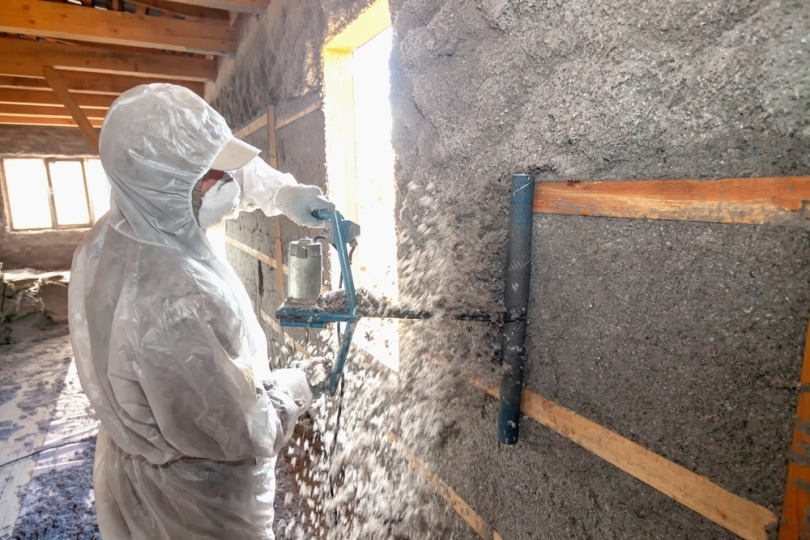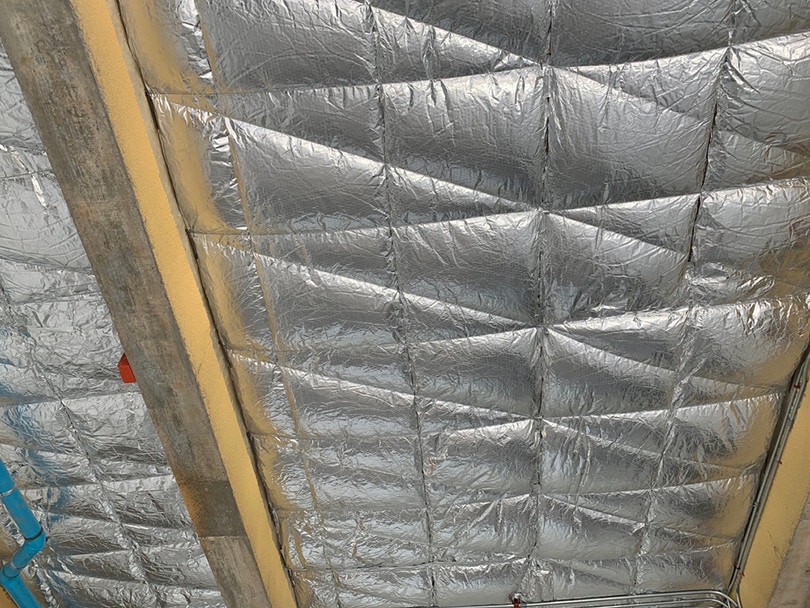What Is R-Value for Insulation? (Chart Included)
-
Pete Ortiz
- Last updated:

R-value is the resistance to heat flow of a chosen material of a given thickness, where a higher R-value indicates a good insulating material, and a low value means a poor insulating material. It can be calculated by dividing the thickness of the material by that material’s thermal conductivity. However, this does necessitate knowing the thermal conductivity of the material being used. R-value is commonly seen in insulation materials and other construction materials.
Insulation and Its Role
We most often see mention of R-values when looking at loft and wall insulation materials or general building materials to construct walls and ceilings. It is one of several figures that manufacturers publish, and while you can get away with simply knowing that a bigger R-value represents a better insulating material, it isn’t quite as straightforward as that
The R-value is affected by the thickness of the material, while materials like mineral wool act differently from materials like plywood. For the most part, however, assuming that all else is equal, a higher R-value represents greater thermal efficiency and better insulation properties.

What Is Thermal Conductivity?
To calculate the R-value of a material, we first need to know that material’s thermal conductivity. Thermal conductivity is also known as Lambda and is represented by the Greek letter for Lambda (λ). This is how well heat can pass through a specific material. Thermal conductivity does not take into account the thickness or number of layers of the material, however, which is where R-value is beneficial.
Whereas a higher R-value is considered better for insulation, lower thermal conductivity literally means that less heat is able to pass through the material. A lower thermal conductivity, or Lambda, is considered better for insulating material.
Determining Thermal Conductivity of Insulating Materials
In some parts of the world, especially in Europe, manufacturers must list the thermal conductivity value of a material in order to sell it as insulating or construction material. In the US, however, there is no such requirement and many manufacturers do not list this value. However, R-values are more easily found on US products.
Where Lambda values are not displayed on product packaging or in product materials, it should be possible to find out online. It is also worth noting that declared Lambda values are calculated in laboratory testing and the real value can be different from this.
Most designers add 20% to the declared value to get a design value, or real value, because this allows for some discrepancy and differences in factors like temperature and ageing of the material. For a quick R-value calculation, this isn’t strictly necessary.
Consult an insulation expert
Find an insulation specialist in your area, and get free, no-commitment estimates for your project.


How to Calculate R-Value for Insulation
Once you have the Lambda value of a material, the only other figure you need to know is the thickness of that material, as measured in inches.
- l = thickness of the materials (measured in inches)
- λ = thermal conductivity
Measuring the R-Value of a Structure
Most walls consist of more than a single layer of materials, and if you need to determine the R-value for the whole wall, you can add the R-values for each layer of that wall. For example, calculate the R-value for the outer bricks, the insulation layer, and the internal plasterboard. This way, you can determine the differences in different wall types and wall styles, as well as when using different insulating materials.

Using R-Values
You will likely need to use R-values when determining the efficiency of different insulating materials, including in walls or in lofts and ceilings. Higher numbers mean that you will enjoy better insulation, while lower numbers mean poor insulation.
It is recommended that exterior walls have an R-value between 13–23, while ceilings and attics should have an R-value between 30–50. The recommended values do vary according to the climate where you live with colder areas requiring a higher R-value in their insulation.
Material R-Value Chart
Below is a table of R-values for some of the most common insulation materials, including blanket insulation (batt) and insulation for walls and attics. The exact thermal insulation and, therefore, R-value, can vary from one product to another, so we have taken an average to give a rough idea of the best available materials.
| Material | 3.5” | 10” | 12” | 15” |
| Fiberglass (batt) | 11.2 | 32 | 38.4 | 48 |
| Mineral wool (batt) | 11.2 | 32 | 38.4 | 48 |
| Fiberglass blown (attic) | 11.2 | 32 | 38.4 | 48 |
| Mineral wool blown (attic) | 12.6 | 36 | 43.2 | 54 |
| Cellulose blown (attic) | 11.9 | 34 | 40.8 | 51 |
| Fiberglass blown (wall) | 14 | 40 | 48 | 60 |
| Mineral wool blown (wall) | 12.6 | 36 | 43.2 | 54 |
| Cellulose blown (wall) | 13.3 | 38 | 45.6 | 57 |
| Polystyrene board | 15.4 | 44 | 52.8 | 66 |
| Polyurethane board | 21 | 60 | 72 | 90 |
| Open-cell spray foam | 12.25 | 35 | 42 | 52.5 |
| Closed-cell spray foam | 22.05 | 63 | 75.6 | 94.5 |
Can You Over Insulate a House?
The aim of insulating a house is to effectively form a barrier to prevent hot air from escaping, but if you do add too much insulation, it can prevent moisture from escaping which can lead to mold growth. Plus, the internal climate may become too hot and stuffy. If a property is over-insulated, however, especially with ventilation systems and other systems within a house, it is virtually impossible to over-insulate to this extent.

What R-Value Is Best for Insulation?
The ideal R-value for insulation depends on a number of factors, but, generally speaking, the higher the R-value the better. If you live in a warm climate, you will not need as high an R-value as people that live in a cold area. Generally, homeowners are advised to aim for an R-value between 13–23 for exterior walls and between 30–49 for attics.
What R-Value Should My Attic Have?
Desirable R-values depend on where you live, but attics should have an R-value of 30, 38, or 49, with the higher numbers providing more insulation in cold areas and lower numbers being suitable in warmer climes.
Conclusion
R-value is commonly seen on insulation material packaging and materials. It is the amount of resistance to heat flow that a material has and is determined by the thermal insulation value and thickness of the material. A material with a higher “R” number is a better insulator than a material with a low number, and the desirable number is primarily determined by how cold it gets where you live.
- https://www.fxsolver.com/browse/formulas/R-value+%28insulation%29+of+a+multi-layered+installation+-+U.S.+units
- https://www.jm.com/en/homeowner-insulation/homeowner-faq/what-r-value-do-i-need-/
- https://emu.systems/2016/02/29/insulation-materials-discovering-the-lambda-value/
- https://www.greatdayimprovements.com/insulation-r-value-chart.aspx
- https://www.idealhome.co.uk/property-advice/what-is-the-r-value-for-insulation-302479
Featured Image Credit: Olivier Le Moal, Shutterstock
Contents



